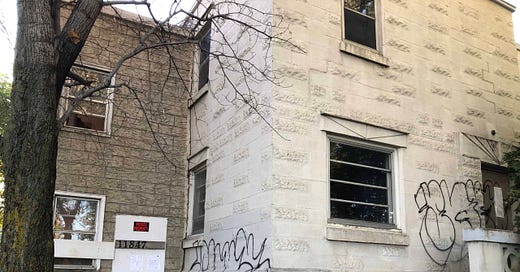If you’ve heard of this 119 Avenue home (dubbed “The Castle”) before, it’s no surprise. In 2022, Rat Creek Press covered the challenges of “problem properties” across North Edmonton, focusing on this local landmark. Behind the unique build and finishings were challenges for the Edmonton Police Service (EPS), residents, and tax adjusters. Together, these groups tried to find ways to maintain homes that neglectful owners had abandoned — often to the advantage of squatters.
Despite the City of Edmonton's promise of action plans, problem properties continue to concern local homeowners and families. For The Castle, this inaction meant waiting over six weeks for the city to barricade entrances and exits to prevent unwanted visitors from accessing the building and continuing a trend of fires that had plagued the Alberta Avenue community.
Today’s article is a much different take on The Castle. As local realtor Jerry Aulenbach explores the property, he outlines a new path forward for this one-of-a-kind home and others like it — provided you have enough elbow grease.
“If you were brave as to take this project on — designated as a historical resource — and restore it, the city will match up to $100,000,” he says.
The City of Edmonton provides this funding as part of its commitment to restoring and preserving historic resources. Up to $100,000 in grant money (and an additional $6,000/year in maintenance funding) is available for the owner of an approved historical property to renovate it and return it to a livable state. As The Castle is a triplex, this could transform the run-down property into multiple beautiful homes.
Interested? With $100,000 on the line, get to know the history of the most exciting DIY project on the Avenue:
Born in 1893 in Northhampton, England, a young boy named Walter Clevely came to Alberta in 1906 with his parents. He went on to work on the Grand Trunk Pacific Railway and later settled permanently in Edmonton. A couple of busy years followed, with Clevely helping to develop the Dawson Bridge in 1911 and marrying the daughter of a local Anglican clergyman in 1912. By 1935, he was elected as a new city alderman and in 1942 he obtained permits to begin the construction of a “British-style cottage” made entirely of concrete. The Castle was completed in 1944, where Clevely took up residence until his passing in 1961.
Today, the property looks much different than Clevely could have imagined. Soot and soil cling to the walls and stone fences, and cracks in the paint invite in the harsh elements. The utility hookups are pulled and barred. Boards and warning signs are drilled tightly into each window and doorway. All that is missing from this modern portrait of The Castle is a moat and an alligator to turn visitors away.
Despite the visible disrepair, viewers can virtually tour the property through Aulenbach’s vlog. The walkthrough also serves as a challenge for contractors and handypeople who want to be a part of Edmonton’s history books while turning a profit for themselves.
It’s important to note that the city funding will match the property owner’s input. For a buyer who sees the potential in Clevely’s masterpiece, it means their vision for flipping the property should start with a $200,000 budget.
While it’s tempting to tear these houses down before they become bigger issues, grant funding for renovations exists to help locals improve their neighbourhoods through creative efforts. In addition, increased taxes for problem properties encourage absentee landlords to sell to someone who will give the property the attention it deserves.
Whether you think The Castle is a charming corner house or an eyesore, learning to live with a problem property is a part of life in a character neighbourhood. The city’s two-step approach (increased funding for renovators and property supply for buyers) empowers locals to create stronger communities while honouring the neighbourhood's uniqueness. With some hard work, properties like The Castle have a chance at returning to glory instead of simply depreciating to their land value.
Echoing Aulenbach’s words, we end with a pressing question for this unique slice of history:
“What do you think? Save? Or Scrap?”






Nice article. I've walked by many times and wondered about this building. I hope someone sees potential.
The building has sold! We'll do a follow up article in the future.